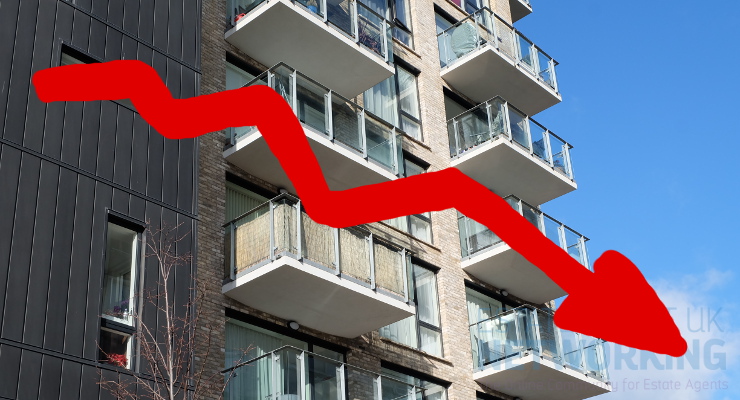Sales still strong, but prices fall in June for first time since 2009
- The number of sales agreed at this time of year is the second highest for ten years, only slightly lower than the high of May 2014
- However, spring price momentum stalls as price of property coming to market drops by 0.4% (-£1,172), the first fall in June since 2009 at the height of the credit crunch, and the first fall this year
- Some markets struggling against headwinds, whilst others still have following wind despite uncertainty:
- Northern markets motoring ahead with an 11% increase in sales agreed year-on-year, compared to only a 3% increase in the South
- First-time buyer sector sees newly-listed prices surge 3.5% month-on-month and 5.5% year-on-year
Overview
This month sees the number of sales agreed at this time of year up 7% on the same month a year ago, and it is the highest seen in May for ten years with the exception of a slightly better figure in 2014. However, there is a fall in the price of property coming to market of 0.4% (-£1,172), the first price fall at this time of year since 2009, and the first monthly fall this year. As a consequence, the annual rate of price increase has slowed to 1.8%, the lowest since April 2013.
Miles Shipside, Rightmove director and housing market analyst comments: “It now seems certain that we will have continuing political uncertainty, which the housing market traditionally dislikes, and with the first fall in June prices for eight years there is no doubt that the lack of stability is a factor. The price of property coming to the market had increased in June in every year since 2009, so buyer confidence has clearly been affected by inflation outstripping their pay packets and current political events. However, demand is still high and markets in some parts of the country seem to be getting used to coping with instability and are still strong. The high levels of sales being agreed show that the underlying fundamentals are largely unchanged with high first-time buyer demand which drives movement higher up the ladder, all aided by the cheap cost of borrowing.”
Markets performing at different speeds and levels depending upon geography and sector
The national average figures conceal large differences between different local markets and property sectors, which appear to be reacting in widely variant reactions to the country’s overall air of uncertainty.
The typical first-time buyer sector with two bedrooms and fewer is now the fastest growing sector, and has seen newly-listed prices surge by 3.5% month-on-month and 5.5% year-on-year.
Shipside observes: “Those at the traditional starter level are brushing aside uncertainty, with demand being fuelled by the ongoing desire for home-ownership, government assistance, and mortgage repayments often being cheaper than rent for a similar property. Increasing prices in this sector have not been enough to shake off the wish to own your first home, whilst in contrast sectors higher up the ladder with a larger proportion of discretionary movers have seen the greatest recent price wobbles.”
The number of sales agreed compared to a year ago is up markedly more in the northern regions than in the South. All regions are up on the post-stamp-duty lull period of May 2016, with a national uplift of 7%, but the northern average of 11% far outstrips the southern average of 3%. This follows through to property prices with the London (-2.4%) and South East (-0.9%) regions recording the largest monthly falls in the price of property coming to market. These London and South East figures account for a significant proportion of the total market and have dragged down the national figure which would be in positive territory without these two slower-performing regions.
Shipside adds: “The swingometer may be leaning towards a buyers’ market in some parts of the country, having been given another tilt in that direction by political uncertainty, but demand for housing and lack of buyer choice are maintaining a sellers’ market in others. London and its commuter belt are proving to be a drag on the national figures, but are currently counter-balanced by continuing momentum in other parts of the country. Markets traditionally slow in the second half of the year, and with a slowing in the pace of asking price rises and the forthcoming months of political and economic confusion, the usual slower market in the second half of the year seems to be one of the few certainties in 2017. Having said that, the historic under-supply of the right property at the right price and ongoing strong housing demand are evidenced by buyer enquiries to agents picking up to a degree after the surprise election result. They were 3% higher on the Monday after the election than the Monday before, showing that people are getting on with addressing their housing needs.”
Agent’s View
Kevin Shaw, national sales director at estate agency Leaders, comments: “May was a bumper month for Leaders in terms of sales, despite the general election. Since the 8th June, even with the continuing political uncertainty, it’s very much business as usual for the property market. Whilst some people may be adopting a wait and see approach, many more are wanting – or needing – to press on with their property transactions. We have, however, started to see a slight hardening of attitude from buyers so sellers need to have realistic expectations and be prepared to be flexible in negotiations.”









